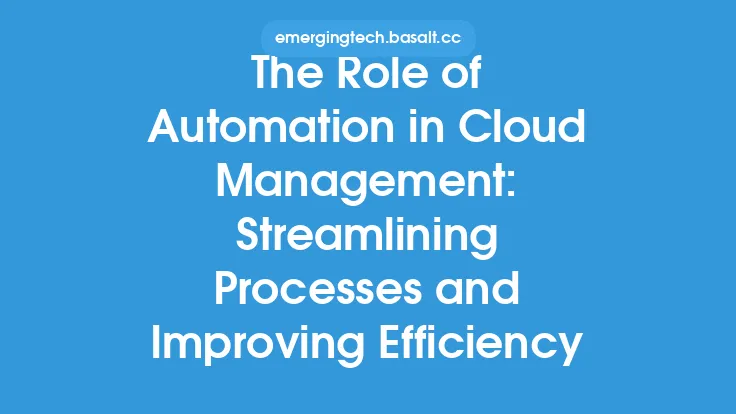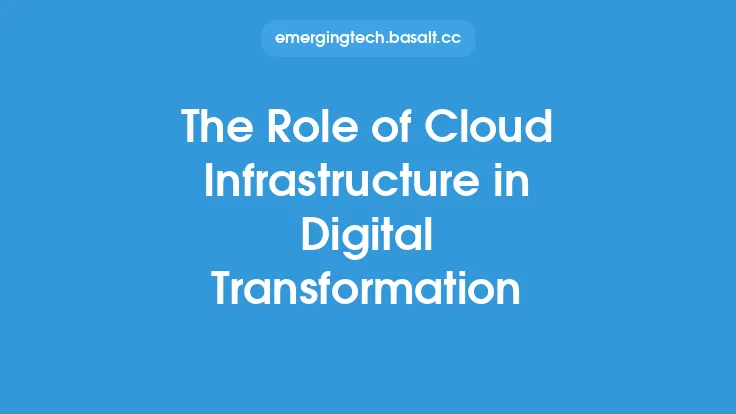Serverless computing has revolutionized the way developers design, deploy, and manage applications, and its impact on DevOps and continuous integration (CI) is particularly significant. By allowing developers to focus on writing code without worrying about the underlying infrastructure, serverless computing enables faster time-to-market, improved collaboration, and increased efficiency. In this article, we will explore the role of serverless computing in DevOps and CI, and how it can help organizations streamline their development processes and improve overall quality.
Introduction to DevOps and Continuous Integration
DevOps is a set of practices that aims to bridge the gap between development and operations teams, promoting collaboration, automation, and continuous improvement. Continuous integration, on the other hand, is a key aspect of DevOps that involves integrating code changes into a central repository frequently, usually through automated processes. The goal of CI is to catch errors and bugs early in the development cycle, ensuring that the codebase remains stable and reliable. Serverless computing can play a crucial role in DevOps and CI by providing a flexible, scalable, and cost-effective platform for deploying and managing applications.
Serverless Computing and DevOps
Serverless computing can enhance DevOps practices in several ways. Firstly, it allows developers to focus on writing code without worrying about the underlying infrastructure, which enables faster development and deployment cycles. Secondly, serverless computing provides a scalable and flexible platform for deploying applications, which means that developers can quickly respond to changing requirements and user demands. Finally, serverless computing enables organizations to adopt a more agile and iterative approach to development, which is a key principle of DevOps. By using serverless computing, organizations can break down monolithic applications into smaller, more manageable components, and deploy them independently, which improves overall system reliability and maintainability.
Serverless Computing and Continuous Integration
Serverless computing can also improve continuous integration processes by providing a platform for automating testing, building, and deployment of applications. With serverless computing, developers can write code, commit it to a repository, and trigger automated build and deployment processes, all without worrying about the underlying infrastructure. This enables faster feedback loops, improved collaboration, and increased efficiency. Additionally, serverless computing provides a range of tools and services that can be used to automate CI processes, such as AWS CodePipeline, Google Cloud Build, and Azure DevOps. These tools provide a scalable, flexible, and cost-effective platform for automating CI processes, which enables organizations to improve overall quality and reduce time-to-market.
Technical Benefits of Serverless Computing in DevOps and CI
From a technical perspective, serverless computing provides several benefits in DevOps and CI. Firstly, it enables organizations to adopt a more microservices-based architecture, which improves overall system reliability, maintainability, and scalability. Secondly, serverless computing provides a range of tools and services that can be used to automate testing, building, and deployment of applications, such as AWS Lambda, Google Cloud Functions, and Azure Functions. These tools provide a scalable, flexible, and cost-effective platform for automating CI processes, which enables organizations to improve overall quality and reduce time-to-market. Finally, serverless computing enables organizations to adopt a more event-driven architecture, which improves overall system responsiveness, scalability, and reliability.
Real-World Examples of Serverless Computing in DevOps and CI
Several organizations have successfully adopted serverless computing in their DevOps and CI practices. For example, Netflix uses AWS Lambda to automate testing, building, and deployment of applications, which enables faster time-to-market and improved overall quality. Similarly, Airbnb uses Google Cloud Functions to automate CI processes, which improves overall system reliability, maintainability, and scalability. These examples demonstrate the potential of serverless computing to improve DevOps and CI practices, and highlight the benefits of adopting a more agile, iterative, and automated approach to development.
Challenges and Limitations of Serverless Computing in DevOps and CI
While serverless computing provides several benefits in DevOps and CI, there are also several challenges and limitations to consider. Firstly, serverless computing requires a significant cultural shift, as developers need to adopt a more agile, iterative, and automated approach to development. Secondly, serverless computing requires a range of new skills and expertise, such as cloud computing, DevOps, and CI. Finally, serverless computing can be complex to manage and monitor, particularly in large-scale deployments. To overcome these challenges, organizations need to invest in training and development, adopt a more agile and iterative approach to development, and use a range of tools and services to automate and monitor serverless computing deployments.
Best Practices for Implementing Serverless Computing in DevOps and CI
To get the most out of serverless computing in DevOps and CI, organizations should follow several best practices. Firstly, they should adopt a more agile and iterative approach to development, which involves breaking down monolithic applications into smaller, more manageable components. Secondly, they should use a range of tools and services to automate testing, building, and deployment of applications, such as AWS CodePipeline, Google Cloud Build, and Azure DevOps. Finally, they should invest in training and development, to ensure that developers have the skills and expertise needed to work with serverless computing platforms.
Conclusion
In conclusion, serverless computing has the potential to revolutionize DevOps and CI practices, by providing a flexible, scalable, and cost-effective platform for deploying and managing applications. By adopting serverless computing, organizations can improve overall quality, reduce time-to-market, and increase efficiency. While there are several challenges and limitations to consider, the benefits of serverless computing in DevOps and CI are clear. By following best practices, investing in training and development, and adopting a more agile and iterative approach to development, organizations can get the most out of serverless computing and improve their overall DevOps and CI practices.





